Table 4.
Art therapists’ observation of the art products and mental health.
| Art product, instruction and preliminary diagnosis by psychiatrist or psychologist | Art product | Mental health according to the art therapists in this study | Formulated focus and duration of treatment | ||
|---|---|---|---|---|---|
| Combination of formal elements - > structure | Variation | (Im)balance | Adaptability | ||
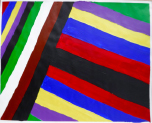 Art product 1 Instruction: Painting free choice with acrylic paint; third session Client 1: Female, age 48, panic disorder, eating disorder (bulimia), depressive disorder, personality disorder |
All therapists mention and agree on the clear high structure; contour and repetition are dominant present; the lines are placed straight to each other and the colors are, almost symmetrical, repeated. Movement and dynamic are dominate absent. The presence of color saturation and absence of mixture of color enhance contour and weaken movement and dynamic and enforce the high structure. Two therapists mention figuration (abstract). | All therapists mention and agree on the very limited variation; there is no differentiation. | Therapists find this client to be out of balance; very much thought; cognitive control and limited/ no feeling; restriction of allowing and expressing emotions. | This client is found to be the least adaptive (not open to experiment, not flexible because of the lack of variation and differentiation and not creative because of the need for predictability, yet some therapists mention that they find the art product powerful; a sort of statement related to self-determination). This client is described as anxious, neurotic and rigid. Overall, the therapists are not positive about treatment outcome and duration. | Therapists estimate that this client may benefit from affective experiences that allow access to and express feelings instead of controlling or avoiding them. However, they are cautious about how much the client needs the control of emotion as a defense. Therefore they expect more time may be needed in treatment. |
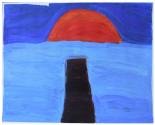 Art product 2 Instruction: Painting a landscape with acrylic paint; first session Client 2: Female, age 20, Anorexia nervosa purging type |
The therapists agree on the high structure; all of them mention the presence of rhythm (repetition of horizontal lines/ movement), high color saturation, figuration, the calm dynamic and contour that is enhanced by limited mixture of color and color saturation. | All therapists mention and agree on the limited variation; monotonous and without differentiation. | Therapists find this client to be out of balance;
having tendency toward thought and cognitive control out of fear to loose control over emotions. Three therapists find this art product a bit alarming by the lack of vitality. |
This client is found to be limited adaptive (limited open as she seems to vary and experiment, limited flexible by the strong repetition, monotone movement and lack of differentiation, no creativity by the standard/ obvious and realistic figuration and limited yet some self-determination as the client seems to intentionally chooses this figuration and tries to work precise, yet not making the effort to correct “mistakes”). | To expand this client’s adaptability, the therapists prioritize stabilization and reinforcement of self-determination by enhancing affective experiences. The therapists are cautious positive about this client’s ability to change (she seems to be less stuck/ rigid as client 1 by the presence of some movement). |
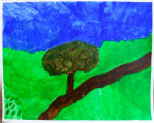 Art product 3 Instruction: Painting a landscape with acrylic paint; first session |
Art product 3 The therapists agree on figuration (stylistic with no detail), repetition (rhythm of upward movements), contour (not dominate, yet present) and dynamic (seven therapists said to find it mechanically, one lively). Therefore the structure of this product is relatively high. Six therapists mention there is almost no mixture of color. Four therapists mention color saturation (varying but mainly transparent). These elements enhance the structure. |
All therapists mention and agree there is some, yet restricted variation (a little bit more in art product 3 as in art product 4). | The therapists are less explicit and use diverse terms with regard to balance. In general this client is described as composed, tensed and tending toward thought; having the ability to regulate, but preferring to withhold from expressing emotion. | Therapists agree on this client’s adaptability (some openness by little experimentation but sticking to what is familiar, limited flexibility by lack of differentiation, no creativity by the very basic and obvious figuration which indicates no exploration and no diversion from the first idea, some self-determination by the choice of figuration, however, performed accidentally not seeing other possibilities). | The therapists are cautious positive about change; the limited amount of differentiation is seen as an opportunity to reinforce in treatment. However, some therapists question the client’s potential due to intellectual restrictions. |
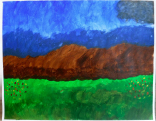 Art product 6 Instruction: Painting a landscape with acrylic paint; second session Client 3: Female, age 33, Borderline Personality Disorder (main), depressive disorder recurrent moderate, problems related to upbringing children and work. |
Art product 6 Seven therapists immediately mention that art product 3 and 6 seems to be made by the same client. They agree that art product 6 tends to be highly structured, as contour is present by the distinction of the blocks of color. Yet there is some overlap. There is repetition by the rhythm of movement. Movement and dynamic are not completely absent. There is only little mixture of color. Color saturation varies between covered and dry. There is some figuration, mainly by the use of color. Six therapists have subjective associations, which are diverse but all related to the cloud. |
||||
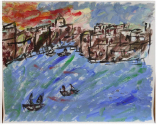 Art product 4 Instruction: Painting a landscape with acrylic paint; first session Client 4: Female, age 48, Personality disorder (main), depressive disorder recurrent moderate. |
All therapists mention the presence of movement and dynamic in combination with presence of figuration and some amount of repetition. Seven therapists mention contour, five mention color saturation varying between saturated and transparent/dry and four mention the presence of mixture of color. They agree that this art product is not completely chaotic or organized structured, yet slightly tending toward chaotic. | All therapists agree on the presence of variation. | Compared with the other clients in this study, the therapists find this client most balanced; despite having a tendency toward feeling, yet showing aspects of thought.. | Therapists agree on this client’s adaptability (open as she seems to be experimenting and exploring, flexible as she seems to differentiate, creative as she seems not to be restricted to what is familiar or obvious, some limited self-determination as her impulses may block her from cognitive control. | Therapists are optimistic about change. They estimate that this client may benefit from cognitive experiences to develop the ability to stop and reflect and develop more cognitive control over feelings in order to enhance autonomy. |
 Art product 5 Instruction: Painting free choice with acrylic paint; third session Client 5: Male, age 34, addiction (cocaine, alcohol) (main), dysthymic disorder, borderline personality disorder |
All therapists agree on all formal elements and the rather low structure, even though it not completely lacks structure. Movement and dynamic (characterized as impulsive/forceful and contained/ restricted at the same time) are dominant present. These are enhanced by the presence of color saturation and mixture of color. Contour is not completely absent; the white paper creates distinction between the paper and the paint. Also repetition is present to some degree; horizontal and vertical lines are layered up, yet are less repetitive as the lines in art product 1. | All therapists agree on variation; limited present, all though the effect of paint seems to be repeated. | The therapists find this client out of balance toward feeling by the physically, yet not completely chaotic or impulsive, expression of feeling and some cognitive control. | Art therapists are moderate positive about this client’s adaptability (openness seems to be restricted by the repetition of the discovered effect of the paint, which may withhold this client from being creative, some flexibility by differentiation between expressing and structuring, presence of self-determination | Art therapists question this clients’ ability to change. They estimate that this client may benefit from experiences that expand the potential to regulate affect. |
